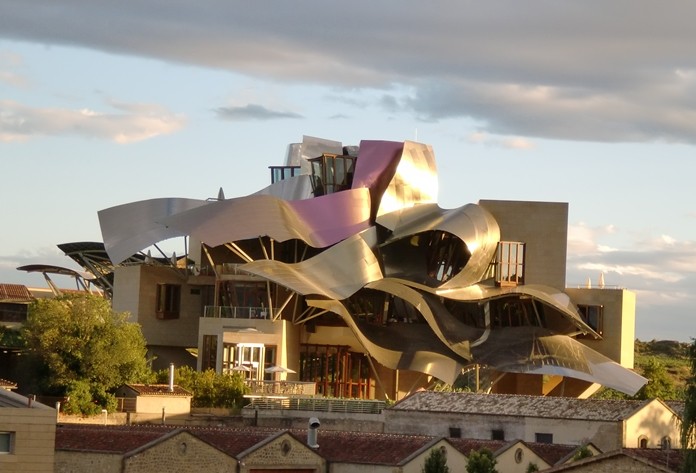
Yesterday afternoon I was looking through a newsletter from a wine company in Bangkok and I was mildly surprised to see some Rioja among their offerings. You might not be familiar with the name and I have to admit you don’t see them around here very often. For many people, the name itself is a bit of a challenge. Being Spanish, the “j” is pronounced like the “ch” in the Scottish word “loch” or a bit like the “ch” that occurs in many German words. The entire word should come out something like ree-OCH-ah but I don’t suppose it matters very much how you say it around here.
You could be forgiven for assuming that Rioja is the name of a grape, but it’s a place, or more accurately, a wine region. The name comes from the river that flows through the region, the Rio Oja. Here they produce some of the best wines in Spain. Rioja lies in the far north of the country, not far from the border with France and about 120 miles south of Bilbao. Wine making in this region has a long history, so long in fact that no one is really sure exactly when it began. The origins of Rioja go back to the Phoenicians and there is certain evidence that grapes were grown in La Rioja during the ninth century. In medieval times, La Rioja had many vineyards which were tended by monks, a common practice at the time. Today the vineyards cover about 160,000 acres. Most of the region produces red wine but the whites are also interesting.
I first discovered Rioja about forty years ago and intrigued by the elegant Bordeaux-shaped bottle surrounded by its traditional golden wire mesh. I took the bottle home and thus began a long love affair with this splendid wine which, along with Sherry, seems to me the epitome of Spain. The Bordeaux-shaped bottle is perhaps not a coincidence because at first the wine reminded me of Cabernet Sauvignon. But there was something else. It reminded me of Spain, the gloomy interiors of the country houses, the dark and heavy furniture and the rich textures of traditional Iberian fabrics. The wine had a “sense of place” which I found captivating. Perhaps it’s something to do with the grape variety. You see, Rioja’s dominant grape is the Tempranillo, the great red grape of Spain. It’s been grown there for over two thousand years and shows up all over the country with the result that it has several local names including Abundante, Tinto Fino and Tinta de Toro. Sometimes another grape, the garnacha (known in France as the Grenache) as added to Rioja to create a richer fruitier taste. In 2007, the wine regulating body for the Rioja region decided to allow several more local grapes to be used in the making of Rioja.
Young, red Rioja is a dark wine with medium acidity, substantial tannins and sometimes hints of jam and red fruit. Older wines have a complex aroma with hints of vanilla and coconut which comes from ageing in American oak. Some of the finest Riojas are, to my mind, almost on a par with good Bordeaux and certainly share some of the taste qualities. These older wines often have a silky, smooth texture brought about by several years maturing in oak barrels.
Although Rioja is produced in different parts of the region, that doesn’t really concern us here. It’s more important for the buyer to know the four quality levels of Rioja. The entry level is simply labeled “Rioja”. This has minimal ageing but is low in tannin and high in fruit. If you enjoy light fruity wines, you’ll probably enjoy it. The next level up uses the word “crianza” on the label and it spends a year in oak and a few months in the bottle before it can be sold. This wine has more body and often hints of oak. The next rung of the ladder uses the word “reserva” and these are wines are of noticeably higher quality, having had three years in the barrel. Wines at the top of the tree are allowed to use the words “gran reserva” on the label. These are among the best Riojas that you can get and are required to have at least two years in oak barrels and three years in the bottle. If you are into beef steaks, this is a wine to try with them.
Several excellent brands of Rioja are available in Thailand and the widest choice comes through online sources. Marqués de Riscal have been producing top-class Rioja since 1858 and the winery also has a luxury hotel on site, designed by Frank Gehry using methods he previously employed in the Guggenheim Museum Bilbao. Marqués de Cáceras is also an old-established company and you can obtain their Rionja Crianza for under 900 baht. Wine Connection has the Federico Paternina Banda Azul Crianza for under 600 baht, which is an excellent bargain. Wine Garage sells the CVNE Rioja Crianza for Bt 900 and the excellent Contino Rioja Reserva for Bt 1,900. Wine Garage also has an unusual white Rioja, the CVNE Monopole at Bt 975. I first tasted the 1968 vintage of this wine sometime in the late 1970s and it had turned into a beautifully balanced, dry and elegant wine. I have not tasted recent vintages, but it is sure to make an interesting change from Chardonnay. Rioja wine has so much to offer and so easily available here that it would a shame not to try some of them.
 |
 |
 |




